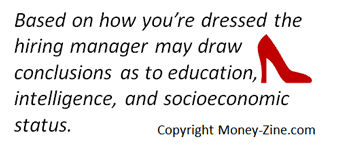Figuring out how to dress for an interview can be a stressful experience. It involves meeting new people, trying to make a good first impression, and wondering what kind of questions they might ask.
Job Interviews
The entire concept of a job interview is really a suboptimal hiring practice. Someone meets with a potential employer, answers their questions, and leaves. The hiring company looks at a resume, puts that information together with the one hour interview, and offers someone a high paying job. Essentially, the hiring manager is making a long term purchase decision based on very little information.
| Additional Resources |
| Preparing for a Job Interview Speed InterviewingInterview Tips Business Meal Etiquette Interview Questions Answering Interview Questions |
Like it or not, that's the decision making process for job offers. Do resumes count in that process? They sure do, but the interview is even more important because the manager doesn't work with a piece of paper, they work with a person. They might love what's written on the resume, but if things don't "click" during the interview, you won't be hired by the company. So the first of our interview tips is simply this: Nail the interview and you'll get the job. We know that last statement is obvious, but it's true. We've talked about answering interview questions in earlier articles. Here we're going to take away some of those meeting jitters by discussing how to dress for an interview. By removing some of the worry about what you're wearing, it's possible to concentrate on the question and answer process.
Dress for Interview Success
Have you ever noticed someone's shoes that were all scuffed up? How about a woman's skirt that had a ripped hemline or a ripped stocking? Did you ever see a man wearing a shirt that was so wrinkled it looked like he just pulled it out of the hamper? What happened when you saw these things? What conclusions did you draw about that person? Did you ever see a woman that was dressed so nicely that she seemed to have a glow about her? Or see a man in a freshly pressed shirt wearing a stylish tie and a well-fitting suit? What impression did they leave you with?

Someone's appearance and the details around their dress style are important during the meeting because they send non-verbal signals to the interview team. Based on how someone is dressed, or what they're wearing, the hiring manager or recruiter might be drawing conclusions as to education, intelligence, socioeconomic status, as well as the desirability as a new hire.
Dress for Success Tips
In the following sections, we'll cover some pretty universally-accepted rules around what to wear during an interview. Not everyone can afford to abide by all these rules but do whatever's possible because first impressions are lasting ones, and that's extremely important when it comes to finding a job.
Clothes that Fit
Make sure the clothes worn to an interview actually fit. You'll want to look business like, but stylish if possible. That means a coordinated outfit that is tailored to your body. Ill fitting clothes look sloppy, and that's the impression you'll leave with the interview team.
Wear Long Sleeves
This might sound silly, but the lack of sleeves on a dress can label you as a social butterfly and not a serious businesswoman. For men, a short sleeve shirt can leave the interviewer with the impression that you're best suited as a backup choice.
Cover those Feet
It's not surprising that many people going on an interview completely ignore what they're wearing on their feet. Don't make that mistake. Shoes are one of the strongest indicators of social status. Cheap shoes are a sign that someone cannot really afford to make their outfit complete. Scuffed shoes are even worse; they tell the interviewing manager that you ignore the details.
Hair Styles
If you want the hiring company to think you're a progressive thinker that would add value to their organization, then you need to lose that 1990s haircut. Yeah, maybe it's served you well for the last 30 years, but it's time for a change. A new job is a great way to start over when it comes to hair styles.
Accessories
Admittedly, women tend to wear more accessories than men, but that doesn't mean that men can ignore this final tip. Dangling earrings are out; simple studs are best for making a good impression during an interview. Metal watches signify strength and endurance, so if you have one, and it goes with what you're wearing, then choose that watch. Scarves and neckties need to send the interview team the impression that you're all business. So leave the long flowing scarves at home alongside the necktie with Snoopy on it that you got for Christmas. (It might be good luck, but why test its powers during an interview?) Again, you're dressing for success and that means looking professional, not necessarily fun.
Investing in Your Wardrobe
It pays to dress appropriately for an interview. If a wardrobe needs an update, then it is money well spent. After all, a high paying job will cover the cost of a new outfit many times over. Finally, keep in mind this is an investment in your future. While it's only in clothes, it's one of the most important investments you'll ever make.
About the Author - Dressing for an Interview


